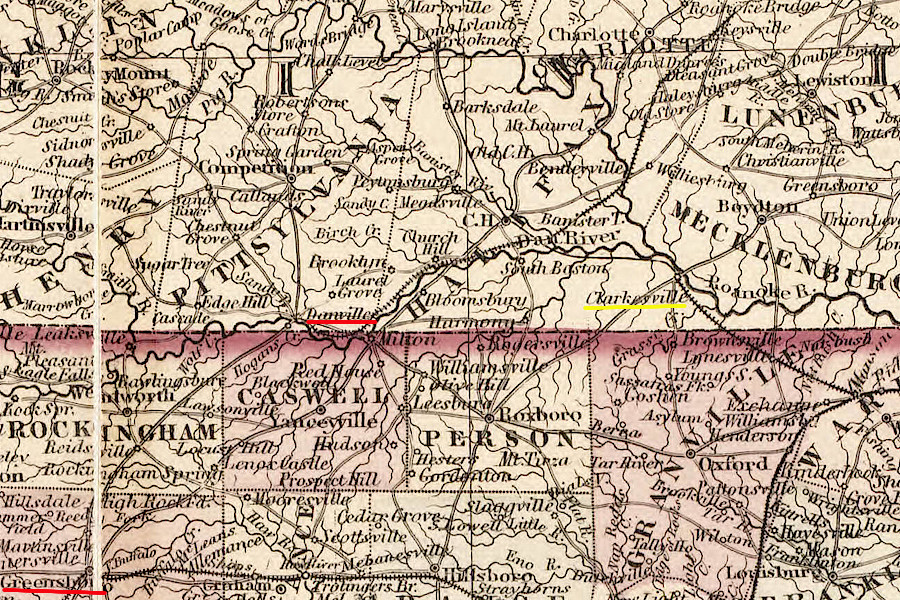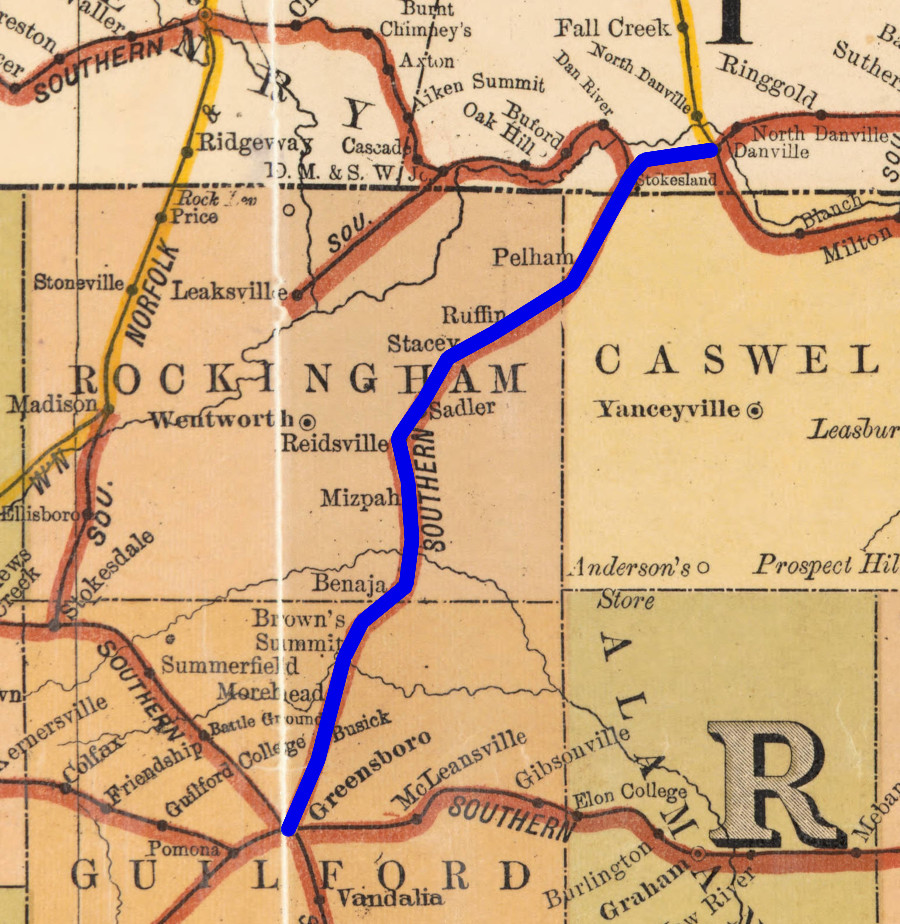
there was no railroad connection between Danville and Greensboro in 1861, at the start of the Civil War
Source: Library of Congress, Lloyd's American railroad map (1861)

there was no railroad connection between Danville and Greensboro in 1861, at the start of the Civil War
Source: Library of Congress, Lloyd's American railroad map (1861)
The Piedmont Railroad linked Danville with Greensboro, North Carolina. Sectional and state conflicts blocked approval from the North Carolina legislature for 15 years. It was constructed during the Civil War, after authorization by the Confederate Congress, in order to expand the capacity and reliability of southern states to supply the armies fighting in Virginia.
Eastern North Carolina officials objected to a connection between the North Carolina Railroad at Greensboro and the Richmond & Danville Railroad. They feared the proposed Greensborough & Danville Railroad ("Danville Connection") would result in traffic being diverted away from the port at Wilmington to a Virginia port. Profits of the Wilmington & Weldon Railroad and the Raleigh & Gaston Railroad would be reduced.
In Southeastern Virginia, the fear was that traffic on the Seaboard and Roanoke Railroad would be reduced. Agricultural products from the Piedmont would be transported to Richmond on the James River, rather than Portsmouth on the Elizabeth River.
The Richmond and Danville Railroad was chartered in 1847. Residents of Western Carolina were frustrated that eastern interests, which controlled the state's legislature, had been slow to improve transportation infrastructure west of Raleigh. In 1849 the North Carolina General Assembly reacted to the threat of a railroad just 40 miles away from Greensboro, by authorizing an east to west railroad that would keep traffic within the state. The state purchased 2/3 of the initial stock issued to build the North Carolina Railroad from Charlotte (via Greensboro and Raleigh) to Goldsboro. By 1858, the state owned 75% of the stock.
At the same time, the North Carolina legislature refused to authorize any railroad that would connect with the Richmond and Danville. It blocked the proposed Charlotte and Danville Railroad, also called the Yadkin and Danville Railroad. Trains reached Danville and Greensboro in 1856.
The advantages of connecting the two railroads restarted the agitation for a Danville Connection. Advocates for a Danville and Greensboro Railroad proposed in 1858 that its gauge could be different from both the North Carolina Railroad (4 feet, 8.5 inches) and the Richmond and Danville Railroad (5 feet). Different gauge widths would make it inefficient to ship North Carolina freight directly to Richmond, because it would have to be moved twice to different railcars at Greensboro and again at Danville.
Advocates also claimed that coal would be shipped from the Danville basin to North Carolina destinations. North Carolina legislators did approve a charter for a Dan River Railroad Company (initially called the Dan River Coalfield Railroad), but poisoned its potential by prohibiting construction within two miles of the state line, within 20 miles of Danville, or within 20 miles of the North Carolina Railroad.
Without the Danville Connection, freight going from Atlanta to Richmond could travel west of the Blue Ridge. Within Virginia, that route required using the Virginia and Tennessee Railroad to Lynchburg, the South Side Railroad to Burkeville, and the Richmond and Danville Railroad to complete the journey. The alternative eastern route required shipping to Weldon, then going via the Petersburg Railroad and the Richmond and Petersburg Railroad to the James River port. Those routes involved riding the rails for 670-705 miles, while a trip via the proposed Danville Connection would be around 570 miles.
In February 1861, the legislature did approve a Greensboro and Leaksville Railroad charter which did not explicitly prohibit a future connection with the Richmond and Danville Railroad, 20 miles northeast of Leaksville. 1

Harpers Weekly incorrectly showed a railroad connection between Danville-Greensboro in 1861
Source: Library of Congress, Map of the southern states, including rail roads (Harpers Weekly, 1861)
Confederate military officials recognized that the supplies needed for the Army of Northern Virginia would have to be imported from the Carolinas, Tennessee, and Georgia. The rail network for transport was fragile. If Federal forces blocked traffic on the Virginia and Tennessee Railroad to the west or the Petersburg Railroad to the east, supplies could not move north.
The Piedmont Railroad was chartered by the Confederate government in 1862, despite the objections of North Carolina that its state's rights were being violated. Prior to the Civil War, the Richmond & Danville Railroad had been delayed in its efforts to extend south. Members of the North Carolina legislature living in the western Piedmont region of North Carolina struggled to overcome objections from those representing Tidewater interests.
There was extensive debate in the Confederate Congress in 1861-62, but it chartered the Piedmont Railroad on February 10, 1862. The Confederacy could have extended the existing Roanoke Valley Railroad north from Clarksville to connect with the Richmond & Danville Railroad at Keysville. By connecting Greensboro to the Richmond & Danville Railroad at Danville, war material and soldiers could be carried from Georgia to Richmond without a detour east to Manson, North Carolina.

the Confederate government chose to connect Greensboro to Danville, rather than extend the Roanoke Valley Railroad north from Clarksville
Source: University of North Carolina, Johnson's North and South Carolina (by A. J. Johnson, c.1861)
Two days before the Confederate Congress chartered the Piedmont Railroad, and well aware of the debates in Richmond, the North Carolina General Assembly finally approved a railroad charter connecting Greensboro and Danville. The route passed through Leakesville, now known as Eden.
Sectional politics were revealed clearly in the decision by the North Carolina legislature. All of the delegates from the Piedmont region, with just three exceptions, voted in favor of the railroad's charter. The opponents were able to mandate use of a 4-foot, 8.5 inch gauge. The Richmond and Danville Railroad gauge was 5-foot. The resulting inefficiency was intentional, based on very realistic fears of post-war integration of the Piedmont Railroad and the Richmond and Danville Railroad.
On March 18, 1862, the Virginia General Assembly authorized that portion of the Piedmont Railroad that would be constructed from the North Carolina border to Danville. Diversion of the North Carolina trade would benefit Petersburg or Richmond after conclusion of the Civil War, so there was minimal controversy in the Virginia legislature.
Building the 50-mile Piedmont Railroad in 1862-63 was challenging. The Richmond & Danville Railroad purchased 14,900 shares of the 15,000 shares authorized, guaranteeing that it would control the Piedmont Railroad. The line was completed in 1863, because the national government of the Confederacy had decided that its construction was a military necessity.

military necessity overcame regional rivalries, and the Confederate government mandated construction of the Piedmont Railroad
Source: Norman B. Leventhal Map & Education Center Collection, Middle Virginia and North Carolina (1864)
The roadbed of the Piedmont Railroad had a minimal number of ties. Some grades were excessively steep because all black powder normally used for blasting railroad cuts was committed to military purposes.
The Confederate States of America lacked the industrial capacity to manufacture new rails. Rails were removed from other lines, including the Roanoke Valley, Richmond & York River, and Manassas Gap railroads in Virginia and the Atlantic, Tennessee & Ohio Railroad in North Carolina. The Seaboard & Roanoke Railroad, in both states, was also scavenged.
In August 1864, Union Army advances interrupted traffic on the Virginia and Tennessee Railroad and the Petersburg Railroad. During the rest of the siege at Petersburg the Piedmont Railroad/Richmond & Danville Railroad became the essential lifeline. It offered the most efficient way to deliver supplies needed by Robert E. Lee's Army of Northern Virginia for the defense of Richmond.2
The Piedmont Railroad/Richmond & Danville Railroad was still operating when the Union Army finally cut the South Side Railroad link to Petersburg on April 2, 1865. General Lee's army evacuated Petersburg; Jefferson Davis and other top Confederate officials caught the last trains on the Richmond & Danville Railroad to Danville. They maintained a capital of the Confederacy there until April 11, when they again caught the last trains out of town. They headed south toward Greensboro, the last Confederate officials to use the Piedmont Railroad.
Soon after the officials' train crossed Reedy Fork on the Piedmont Railroad, Federal cavalry burned the bridge. At Greensboro, most officials spent four days using the train as both hotel and office. The flight south continued on horseback, since the Federal cavalry had torn up all the tracks.3
On June 24, 1865, the US Government seized the Piedmont Railroad. It was declared to be property of the Confederate government, not of the Richmond and Danville Railroad. The US Treasury Department operated it until December 9, 1865. The process for returning the Piedmont Railroad to the Richmond and Danville Railroad, after five months of debate, included a requirement that the Richmond & Danville Railroad reimburse the other railroads from which rails had been seized.
The Richmond & Danville Railroad changed the gauge of the Piedmont Railroad to match the 5-foot gauge on the rest of the line, after North Carolina officials concurred. Trains began to run on the new track in February, 1866. The different gauges had forced freight to be transferred at Danville throughout the Civil War and created an economic advantage for the port of Wilmington after fighting ended. In 1866, the desire for economic recovery within North Carolina and the influence of northern capitalists trumped the state's sectional politics.
The Pennsylvania Railroad obtained control over the Richmond & Danville Railroad in 1871, by purchasing the shares held by the Virginia Board of Public Works. Technically the stock was held by the Southern Railway Security Company, one of the first holding companies designed to acquire multiple railroads and operate them as a system. The holding company was a legal maneuver to bypass state restrictions designed to force traffic from one region to go to a particular port.
The Southern Railway Security Company also leased the North Carolina Railroad, from Charlotte to Goldsboro. That allowed traffic to flow from the Piedmont of North Carolina north, across the Piedmont Railroad, to Richmond.
The Richmond & Danville Railroad retained control over the Piedmont Railroad until 1894. The Piedmont Railroad had been built and managed by the Richmond & Danville Railroad since authorization in 1862 by the Confederate government, but remained an independent corporation. The existence of the Piedmont Railroad disappeared when components of the Richmond & Danville Railroad and the Richmond and West Point Terminal Railway and Warehouse Company ("the Terminal") were folded into the Southern Railway in 1894.4

the Piedmont Railroad still connected Danville and Greensboro in 1900
Source: University of North Carolina Libraries, Railroad map of North Carolina 1900 (by Henry C. Brown, 1900)